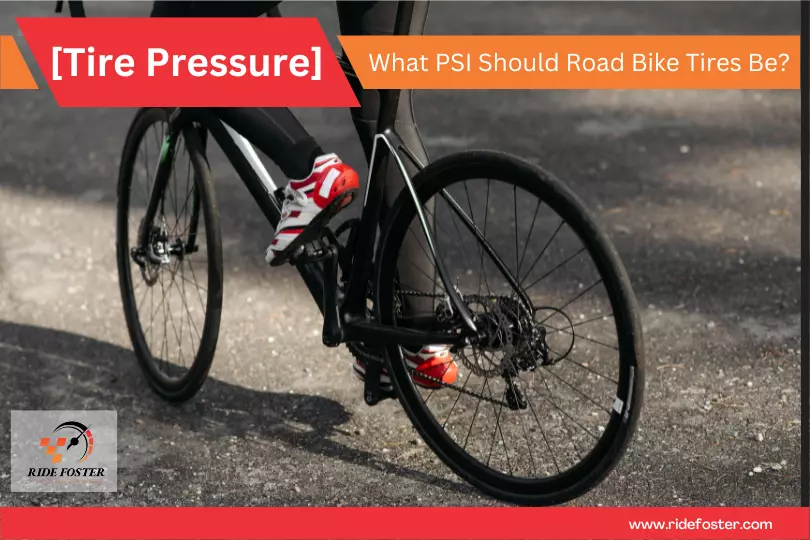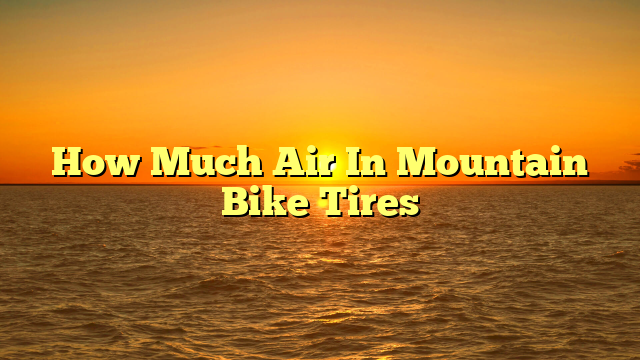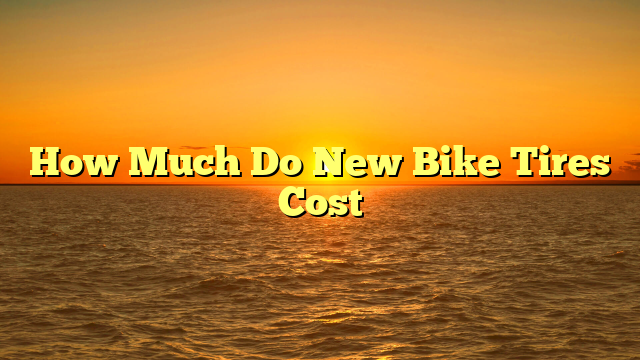When it comes to cycling, tire pressure is a crucial factor that affects performance, comfort, and safety.
The correct tire pressure can make a significant difference in how your bike handles, rolls, and grips the road or trail.
But how much PSI (pounds per square inch) should you put in your bike tires?
The answer is not straightforward, as the ideal pressure varies depending on several factors, such as your weight, riding style, terrain, and tire size.
In this article, we will explore the science behind PSI and bike tires, the factors that affect ideal tire pressure, and how to determine the right PSI for your bike.
We will also provide tips for checking and adjusting your tire pressure, and discuss the consequences of riding with too little or too much pressure.
By the end of this article, you will have a better understanding of how to maintain optimal tire pressure for better cycling performance.
Tire pressure may seem like a trivial aspect of cycling, but it can impact your speed, efficiency, and comfort more than you might think.
A tire that is underinflated can feel sluggish, unstable, and prone to pinch flats, while a tire that is overinflated can feel harsh, bouncy, and prone to blowouts.
The ideal tire pressure should strike a balance between grip, rolling resistance, and shock absorption, depending on your individual needs and preferences.
Moreover, tire pressure can affect the lifespan of your tires, as well as the overall health of your bike.
Therefore, it is essential to understand how PSI works, what affects it, and how to adjust it to suit your riding conditions.
In the following sections, we will delve into the details of tire pressure and explore the best practices for inflating and maintaining your bike tires.
Table of Contents
- 1 Key Takeaways
- 2 Understanding the Importance of Tire Pressure in Cycling
- 3 The Science Behind PSI and Bike Tires
- 4 Factors That Affect Ideal Tire Pressure
- 5 How to Determine the Right PSI for Your Bike
- 6 Tips for Checking and Adjusting Your Tire Pressure
- 7 The Consequences of Riding with Too Little or Too Much Pressure
- 8 Best Practices for Inflating Your Bike Tires
- 9 Maintaining Optimal Tire Pressure for Better Cycling Performance
- 10 Frequently Asked Questions
- 10.1 Can I use a car tire pump to inflate my bike tires?
- 10.2 How often should I check my bike tire pressure?
- 10.3 Is it safe to ride with a slightly lower tire pressure than recommended?
- 10.4 Can tire pressure affect the lifespan of my bike tires?
- 10.5 How do I know if my bike tires need to be replaced?
- 11 Conclusion
Key Takeaways
- Ideal tire pressure varies based on weight, riding style, terrain, and tire size.
- Underinflated tires lead to poor handling, increased rolling resistance, and a higher risk of punctures.
- Overinflated tires result in harsh and uncomfortable ride, reduced traction, and a higher risk of blowouts.
- Check and adjust pressure regularly, at least once a week or before every ride, and follow the manufacturer’s recommended pressure levels found in the owner’s manual or on the tire sidewall.
Understanding the Importance of Tire Pressure in Cycling
The optimal tire pressure in cycling is crucial for achieving maximum performance and efficiency while minimizing the risk of accidents caused by under or overinflated tires.
The psychology of tire pressure management is a critical aspect that every cyclist should understand.
Many factors can affect tire pressure, such as the cyclist’s weight, the terrain, and the weather.
Therefore, it is crucial to check the tire pressure regularly to ensure it is within the recommended range.
The importance of tire pressure in preventing accidents cannot be overstated.
Underinflated tires can lead to poor handling, increased rolling resistance, and a higher risk of punctures.
On the other hand, overinflated tires can result in a harsh and uncomfortable ride, reduced traction, and a higher risk of blowouts.
Therefore, it is crucial to maintain the optimal tire pressure to ensure a safe and comfortable ride.
By understanding the importance of tire pressure management, cyclists can achieve maximum performance, efficiency, and safety on the road.
The Science Behind PSI and Bike Tires
Understanding the relationship between air pressure and the contact patch of a tire can greatly impact the performance of a bicycle.
The contact patch refers to the area where the tire meets the ground, and it is affected by the tire construction and the amount of pressure in the tire.
When a tire is inflated, the air pressure inside creates a force that pushes the tire outward.
This force causes the tire to expand and creates a larger contact patch.
However, if the pressure is too low, the tire will not be able to maintain its shape and will not be able to create a sufficient contact patch with the ground.
Conversely, if the pressure is too high, the tire will become too rigid and will not be able to conform to the surface of the road, leading to reduced traction and a harsh ride.
To ensure that your bike tires are at the correct pressure, it is important to use a pressure gauge.
Pressure gauges are tools that are used to measure the amount of air pressure inside a tire.
They are available in analog and digital formats, and some are designed specifically for bike tires.
Most bike tires require a pressure between 80 and 130 psi, depending on the tire size and the rider’s weight.
However, it is important to check the manufacturer’s guidelines to ensure that you are inflating your tires to the correct pressure.
By maintaining the correct tire pressure, you can ensure that your bike performs optimally and that you have a safe and comfortable ride.
Factors That Affect Ideal Tire Pressure
Various factors affect the ideal tire pressure for a bicycle.
One of these factors is rider weight.
The heavier the rider, the more air pressure the tire needs to support the weight.
On the other hand, a lighter rider may require less air pressure.
Another factor to consider is the terrain.
Rough terrain requires more air pressure to avoid pinch flats, while smoother surfaces require less air pressure for a smoother ride.
Finally, weather conditions also play a role.
Cold weather causes tire pressure to drop, while hot weather increases it.
Tire material also affects the ideal pressure for a bicycle tire.
Different tire materials have different characteristics that affect their inflation requirements.
For example, a tire made of a rigid material like carbon fiber may require more air pressure than a tire made of a softer material like rubber.
Temperature effects are also a critical factor to consider when determining the optimal tire pressure.
As temperature changes, so does tire pressure, which can significantly impact the ride quality and safety of the cyclist.
It is vital to consider these factors when determining the tire pressure to optimize the ride quality and safety of the cyclist.
How to Determine the Right PSI for Your Bike
Calculating the appropriate tire pressure for a bicycle involves considering a variety of factors to ensure optimal ride quality and safety.
The most important factor to consider is rider weight, as this will determine how much pressure is needed to support the weight of the rider and prevent the tires from compressing too much under the weight.
Other factors to consider include the terrain, weather conditions, and tire material, as these can all affect how much pressure is needed to maintain optimal ride quality and prevent damage to the tires.
To calculate the ideal range for tire pressure, it is important to consult the manufacturer’s recommendations for your specific bike model.
These recommendations will take into account the factors mentioned above and provide a range of pressures that are suitable for your bike.
It is important to note that different types of bikes may have different PSI needs, with road bikes typically requiring higher pressure than mountain bikes due to the smoother terrain they are designed for.
By calculating PSI based on these factors and following manufacturer recommendations, cyclists can ensure that their tires are properly inflated to provide optimal ride quality and safety.
| Factor | Ideal PSI Range |
|---|---|
| Rider Weight | 70-90 PSI |
| Terrain | Smooth/Flat: 90-100 PSI, Rough/Mountainous: 30-50 PSI |
| Weather Conditions | Hot: -5 PSI, Cold: +5 PSI |
| Tire Material | Narrow Tires: 100-120 PSI, Wide Tires: 30-50 PSI |
Table 1: Ideal PSI Range based on factors such as Rider Weight, Terrain, Weather Conditions, and Tire Material.
This table can be used as a guide to calculate the appropriate tire pressure for different types of bikes.
It is important to note that these ranges are only a guide, and cyclists should always consult their bike’s manufacturer recommendations for specific PSI requirements.
Tips for Checking and Adjusting Your Tire Pressure
Maintaining proper tire pressure is essential to ensure a safe and smooth ride, and there are a few simple tips that cyclists can follow to check and adjust their tire pressure regularly.
One common mistake that cyclists often make is relying on visual inspection to determine their tire pressure.
However, this method is not accurate, and the tire may be underinflated or overinflated, leading to a less efficient ride or even a dangerous blowout.
Instead, it is recommended that cyclists use a tire pressure gauge to measure their tire pressure accurately.
This tool allows for a more precise measurement of the tire pressure and can help cyclists adjust their pressure to the recommended PSI for their bike.
Another tip for checking and adjusting tire pressure is to be aware of the recommended PSI for the specific bike and tire.
This information can be found on the sidewall of the tire or in the bike manual.
It is important to note that different types of bikes and tires may require different PSI levels, so it is essential to check the recommended pressure for each bike and tire.
By using the correct PSI, cyclists can ensure a safer and more efficient ride.
In conclusion, checking and adjusting tire pressure regularly is an important aspect of bike maintenance.
Utilizing a tire pressure gauge and being aware of the recommended PSI for the specific bike and tire can help cyclists avoid common mistakes and ensure a safe and enjoyable ride.
The Consequences of Riding with Too Little or Too Much Pressure
After learning how to check and adjust your tire pressure, it is important to understand the consequences of riding with too little or too much pressure.
Riding with incorrect tire pressure can significantly affect your riding safety and the lifespan of your bike tires.
Riding with too little pressure can cause the tire to wear unevenly, reduce fuel efficiency, and make steering difficult.
On the other hand, riding with too much pressure can cause the tire to become stiff, reduce traction, and increase the risk of a blowout.
To ensure optimal riding safety and tire performance, it is crucial to maintain the correct tire pressure.
Here are some maintenance tips to keep in mind:
- Check your tire pressure regularly, at least once a week, or before every ride.
- Follow the manufacturer’s recommended pressure levels, which can be found in the owner’s manual or on the tire sidewall.
- Adjust the pressure based on the weight of you and any additional cargo, if applicable.
- Use a reliable tire pressure gauge for accuracy.
- Replace your tires if they show signs of wear or damage.
By following these maintenance tips, you can ensure that your bike tires are always at the correct pressure level, which will not only enhance your riding safety but also increase the lifespan of your bike tires.
Best Practices for Inflating Your Bike Tires
Inflating your bike tires correctly is essential for optimal performance and safety.
Proper technique involves using the appropriate equipment for inflating bike tires, such as a high-quality pump with a gauge that accurately measures the pressure in the tires.
Before inflating, it is important to check the recommended tire pressure, which is typically printed on the sidewall of the tire.
In general, road bike tires require higher pressure than mountain bike tires, and heavier riders may need to inflate their tires to a higher pressure to prevent pinch flats.
Preventing common inflation mistakes is also important for maintaining the integrity of your bike tires.
One common mistake is overinflating the tires, which can cause the tires to become too rigid and increase the risk of a blowout.
Another mistake is underinflating the tires, which can negatively impact performance and increase the risk of pinch flats.
It is also important to check the pressure in your tires regularly, as changes in temperature can cause the pressure to fluctuate.
By following proper technique and avoiding common inflation mistakes, you can ensure that your bike tires are inflated to the correct pressure for optimal performance and safety.
Maintaining Optimal Tire Pressure for Better Cycling Performance
Proper tire pressure is crucial for achieving optimal cycling performance, as it affects factors such as speed, handling, and overall comfort during rides.
Maintaining the correct tire pressure also increases the lifespan of the tire and prevents unnecessary wear and tear.
Here are some benefits of proper inflation and common mistakes to avoid:
- Benefits of proper inflation:
- Improved handling: Properly inflated tires provide better traction, allowing for easier maneuvering and control over the bike.
- Increased speed: Underinflated tires create more resistance, making it harder to pedal and slowing down the bike.
Properly inflated tires reduce this resistance, allowing for a faster ride.
- Enhanced comfort: Overinflated tires can cause a harsh and uncomfortable ride, while underinflated tires can lead to pinch flats and a bumpy ride.
Properly inflated tires provide a smooth and comfortable ride.
- Common mistakes to avoid:
- Not checking tire pressure regularly: Tire pressure naturally decreases over time, so it’s important to check it before every ride.
- Inflating based on the tire’s maximum pressure: The maximum pressure listed on the tire’s sidewall is not necessarily the recommended pressure.
Check the bike’s manual or contact the manufacturer for the correct pressure.
- Not using a pressure gauge: Estimating tire pressure by feel or sight can lead to inaccurate results.
Always use a pressure gauge to ensure proper inflation.
By maintaining optimal tire pressure, cyclists can enjoy a smoother, faster, and more comfortable ride while also prolonging the lifespan of their tires.
Avoiding common mistakes and regularly checking tire pressure can also prevent accidents and ensure a safe cycling experience.
Frequently Asked Questions
Can I use a car tire pump to inflate my bike tires?
Using a car tire pump to inflate bike tires is possible, but caution must be exercised to prevent overinflation, which can lead to blowouts and accidents.
It is important to use a pressure gauge to monitor tire pressure.
How often should I check my bike tire pressure?
Regular maintenance is essential for ensuring the optimal performance and safety of a bike.
Checking tire pressure is a crucial aspect of maintenance.
Tire pressure gauge accuracy must be ensured to determine the appropriate pressure level.
It is recommended to check tire pressure before every ride.
Is it safe to ride with a slightly lower tire pressure than recommended?
Riding with slightly lower tire pressure than recommended may affect riding performance and increase tire wear.
It is important to maintain proper tire pressure for optimal performance and longevity.
Consult the manufacturer’s guidelines for specific recommendations.
Can tire pressure affect the lifespan of my bike tires?
The effect of tire pressure on bike performance is well-documented, with lower pressures leading to increased rolling resistance and decreased handling.
Recommended tire pressure varies by bike type and should be followed to optimize tire lifespan and performance.
How do I know if my bike tires need to be replaced?
Determining when to replace bike tires involves assessing signs of wear, such as cracks, punctures, or worn tread.
Proper maintenance, including regular inspections and inflation, can prolong tire lifespan.
When in doubt, consult a professional for advice.
Conclusion
In conclusion, tire pressure plays a critical role in cycling performance and safety.
The ideal PSI for bike tires depends on various factors such as rider weight, tire size, terrain, and weather conditions.
Cyclists should check and adjust their tire pressure regularly to ensure optimal performance, prevent flats, and reduce the risk of accidents.
Riding with too little or too much pressure can affect handling, traction, and stability, and increase the likelihood of punctures and blowouts.
Therefore, it is essential to follow manufacturer recommendations, use a reliable pressure gauge, and inflate tires accordingly.
To maintain ideal tire pressure, cyclists should also consider using high-quality tires, avoiding overloading their bikes, and storing them in a cool, dry place.
By adhering to these best practices, cyclists can enhance their riding experience, reduce maintenance costs, and stay safe on the road.
Overall, tire pressure may seem like a minor detail, but it can significantly impact a cyclist’s performance and enjoyment.
Therefore, it is crucial to prioritize tire pressure as part of regular bike maintenance.







